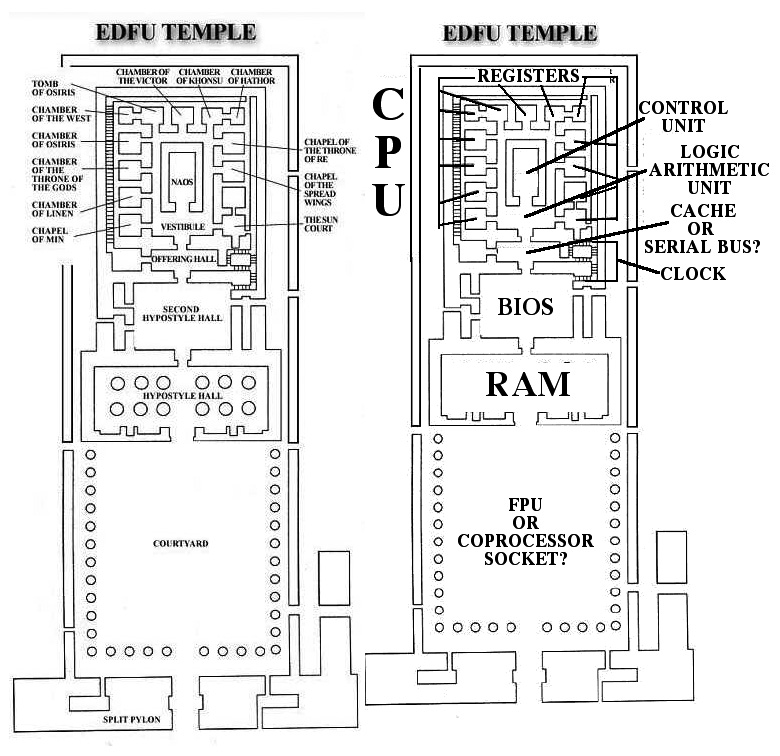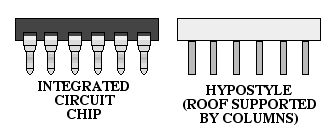Pyramid as computer
An Egyptian temple from 272 B.C. was built as structural equivalent of a CPU
On the west bank of Nile, between Esna and Aswan there's the temple of the high diety with falcon head - Horus, son of Osiris. This is the most preserved in time temple and the second largest in
Egypt after the one in Karnak. The temple of Horus is imposing in size: 36 m high, 79 m wide and 36 m long. However, there's something even more striking about it, someting that has recently
agitated the internet - its structure. It turns out that the temple design is a precise copy of the CPU!
Each section of the Temple of Horus correlated with a segment of a CPU and the surrounding hardware needed for a CPU to function.

THE CPU / INNER SANCTUARY
The most important part of the Temple of Horus, the Eastern end, has a similar structure to the interior of a CPU. The smaller sections consist of Chambers surrounding an Offering Hall, a Vestibule and an area called the Naos, which in ancient Egyptian tradition contains the most important part of this particular temple, a statue of the god Horus.
The NAOS, is obviously the center of the temple and symbolically controls and works in tandem with all of the rituals and tradition surrounding it. In a similar fashion, the Control Unit of a CPU controls and works in tandem with all of the other sections of a microprocessor.
The Chambers surrounding the Eastern End of the Temple would logically be places to store objects or information. Inside a CPU, segments known as registers perform the task of storing information to be processed later.

THE BIOS CHIP / SECOND HYPOSTLE HALL
The lower right of the temple's inner sanctuary (CPU area) are two small sections which resemble miniature integrated circuit chips which are used in computers as system clocks for a CPU.
At the entrance to this inner section of the Temple of Horus is an area called "The Offering" hall, which contains items to be brought from the "Second Hypostyle" hall. The Cache of a CPU contains data that is to be brought from the outside, especially from the next component of a computer, the BIOS chip.
The BIOS chip performs the function of "booting up" the CPU by making sure all attachments are in place, transfers control to the BIOS and loads the program to be used into the Random Access Memory (RAM).
In a similar fashion, the "Second Hypostyle" hall is a gathering place to make the temple ready for "god worship" rituals to be performed, temporarily transfers control of the temple to this hall when the "god worship" ritual is about to begin and is used to bring in the tradition of ritual celebration (a program) for those in the next outer "hypostyle" hall who are not skilled enough to be in the inner sanctuary.
RAM / HYPOSTLE HALL
Random Access Memory is a short term memory used to temporarily hold programs to be used by a computer. In the case of the temple, "the computer" is Egyptian Civilization and the "program" is a celebration held in the outer hypostyle hall for those not qualified or required to be in the inner sanctuary or are temporary members.
COURTYARD / A CO-PROCESSOR SOCKET
The open courtyard of this temple has several pillars surrounding it inside of a wall on three sides. A socket which is used to hold a co-processor chip (or Floating Point Unit) on a computer motherboard would be a logical comparison to this area if the "pillars" are interpreted as "holes" and the open area is the hollowed out area of the "socket".
COINCIDENCE, SCIENCE FICTION OR LOST KNOWLEDGE?
We're all taught that no matter how developped the ancient Egyptian civilization was, it was far from the knowledge and the technologies which we use today. Then how can we explain this striking correlation between the temple structure and the CPU composition? Could it be the temple design is actually a memory for an ancient highly techological society, еxtinct long before the written history began? Or could it be a similarity born in visions of the future, a gift from the Egyptian gods, a clue that one day could be decoded and used... as it happens two and a half thousands of years later.
Each section of the Temple of Horus correlated with a segment of a CPU and the surrounding hardware needed for a CPU to function.

THE CPU / INNER SANCTUARY
The most important part of the Temple of Horus, the Eastern end, has a similar structure to the interior of a CPU. The smaller sections consist of Chambers surrounding an Offering Hall, a Vestibule and an area called the Naos, which in ancient Egyptian tradition contains the most important part of this particular temple, a statue of the god Horus.
The NAOS, is obviously the center of the temple and symbolically controls and works in tandem with all of the rituals and tradition surrounding it. In a similar fashion, the Control Unit of a CPU controls and works in tandem with all of the other sections of a microprocessor.
The Chambers surrounding the Eastern End of the Temple would logically be places to store objects or information. Inside a CPU, segments known as registers perform the task of storing information to be processed later.

THE BIOS CHIP / SECOND HYPOSTLE HALL
The lower right of the temple's inner sanctuary (CPU area) are two small sections which resemble miniature integrated circuit chips which are used in computers as system clocks for a CPU.
At the entrance to this inner section of the Temple of Horus is an area called "The Offering" hall, which contains items to be brought from the "Second Hypostyle" hall. The Cache of a CPU contains data that is to be brought from the outside, especially from the next component of a computer, the BIOS chip.
The BIOS chip performs the function of "booting up" the CPU by making sure all attachments are in place, transfers control to the BIOS and loads the program to be used into the Random Access Memory (RAM).
In a similar fashion, the "Second Hypostyle" hall is a gathering place to make the temple ready for "god worship" rituals to be performed, temporarily transfers control of the temple to this hall when the "god worship" ritual is about to begin and is used to bring in the tradition of ritual celebration (a program) for those in the next outer "hypostyle" hall who are not skilled enough to be in the inner sanctuary.
RAM / HYPOSTLE HALL
Random Access Memory is a short term memory used to temporarily hold programs to be used by a computer. In the case of the temple, "the computer" is Egyptian Civilization and the "program" is a celebration held in the outer hypostyle hall for those not qualified or required to be in the inner sanctuary or are temporary members.
COURTYARD / A CO-PROCESSOR SOCKET
The open courtyard of this temple has several pillars surrounding it inside of a wall on three sides. A socket which is used to hold a co-processor chip (or Floating Point Unit) on a computer motherboard would be a logical comparison to this area if the "pillars" are interpreted as "holes" and the open area is the hollowed out area of the "socket".
COINCIDENCE, SCIENCE FICTION OR LOST KNOWLEDGE?
We're all taught that no matter how developped the ancient Egyptian civilization was, it was far from the knowledge and the technologies which we use today. Then how can we explain this striking correlation between the temple structure and the CPU composition? Could it be the temple design is actually a memory for an ancient highly techological society, еxtinct long before the written history began? Or could it be a similarity born in visions of the future, a gift from the Egyptian gods, a clue that one day could be decoded and used... as it happens two and a half thousands of years later.



